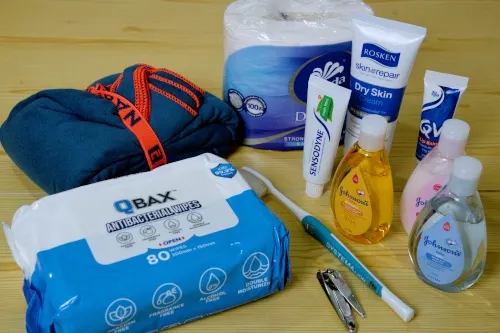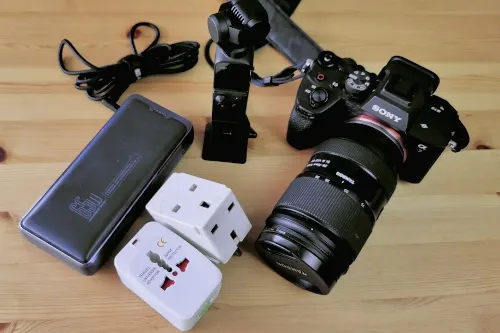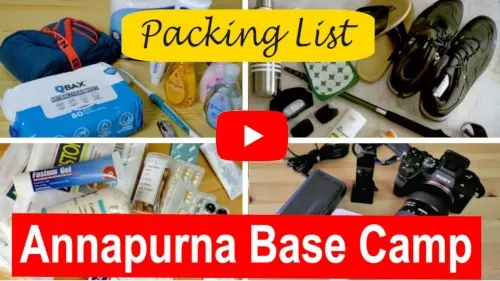
Finally, in two days, we will fly to Kathmandu to mark off another item from my bucket list—trekking to Annapurna Base Camp this Saturday! Before starting our trek, we want to share our Annapurna Base Camp Packing List with you.
Although some may find this task easy, it will be a real test of our physical fitness as we have yet to experience multi-day trekking at higher elevations. Moreover, we are in our sixties, and our strength and endurance will not be comparable to when we were younger.
This article will focus on the items we carry along for the journey. It is a detailed account of the items we bring, and we hope the information will be a valuable resource for you who are embarking on the ABC trek and similar hikes involving high altitude and several days of trekking.
After returning from Annapurna Base Camp, I created a video highlighting the crucial things to know before embarking on the Annapurna Base Camp trek. You can find the video on YouTube. It's very helpful, and I highly recommend watching it.
My Annapurna Base Camp Packing List
We have prepared a printable packing list at the end of this article. It is free, so please download it if you find it helpful. (The download link is at the end of this article)
1. Clothing

We have spent most of our time deciding what clothes to bring.
a. The layers
- Outer layer (Parka and Down jacket) - A down jacket is absolutely essential, as the temperature in April in Annapurna Camp will likely drop to 0°C, especially at night. Our down jacket is suitable for such low temperatures. Although the down jacket is sufficient in most situations, We still want to bring our waterproof and windproof parka as another outer layer, just in case the weather is too cold.
- Middle layer- We have long-sleeved woolen sweaters as our second layer.
- Inner layer- We bring two pairs of thermal base layers. The inner layer is vital when the weather turns cold, especially at night, because the tea houses in the mountains do not have heaters in the room.
b. Rain gear
- We need to bring a poncho or a rain jacket during the track as the weather conditions are unpredictable in the Annapurna region. I chose an oversized poncho, as it will also cover my backpack. If you don't have an oversized poncho to cover your backpack, please bring a rain cover to cover the backpack.
- Windproof and waterproof trousers—The weather at the ABC track is highly unpredictable. Based on the information we have gathered from various sources, it is highly probable that it will rain while trekking. Therefore, we will bring our waterproof trousers, as they will effectively keep us dry, as the ponchos and raincoats do not fully cover the lower part of our body.
c. Other clothes
- Quick-dry shirts- Considering the limited chances of washing our clothes during the hike and the difficulty of drying them quickly, it's practical to wear quick-dry shirts. While our quick-dry shirts are long-sleeved, they won't be too warm for the temperature in ABC Trek. Long-sleeved shirts have two advantages: first, they cover our arms and protect us against ultraviolet rays, so we won't need to apply sunscreen to our hands. Second, they protect our arms from scratches, mosquito bites, and other insect bites so that we won't need any insect repellents.
- Undergarments: Disposable panties are recommended as they are convenient and do not need to be washed. I would prefer using disposable panties, as washing clothes with ice-cold water is not the best experience 🙂
- Gloves: We have two pairs of woolen gloves; if one pair gets wet, we still have another to wear.
- Socks: We bring two pairs of woolen socks to trek at a higher altitude. (Those made with merino wool are the best). We also get extra regular socks to be used in Kathmandu and Pokhara.
- Neck gaiter: A neck gaiter helps cover our neck, nose, and mouth, especially during strong winds or on a dusty trail. It also protects our noses from breathing in cold air. Besides, consider bringing surgical masks to cover your nose and mouth when necessary.
- Hat, cap, beanie- My wife and I will bring hats for lower altitudes while visiting Kathmandu and Pokhara and beanies for higher altitudes and snow.
- We'll also bring extra shorts, jeans, and T-shirts, just in case. We anticipate a long trip of over two weeks and want to ensure we're prepared for anything.
2. Toiletries

- Quick-dry towel: We have quick-dry towels for various purposes, such as taking a bath, washing our faces, and so on. It will be useful as it will dry quickly for subsequent use.
- Toilet paper- We also have toilet paper rolls in our luggage bags, which can be expensive to purchase there. Most tea houses do not provide toilet paper, so it's better to be prepared.
- Wet wipes will help clean ourselves when we decide not to bathe.
- Lip balm and moisturizer- Lip balm and moisturizer are essential to prevent cracked lips and dry feet, which can lead to lesions due to dry weather.
- We also bring a toothbrush, mini toothpaste, and shampoo.
- We also have cloth bags, plastic bags, rubber bands, and string to organize our belongings. These items are not bulky and heavy, so they won't be a hassle.
- Lastly, we have a mini-sized nail clipper and hand sanitizer.
3. Hiking equipment

Here is the list of hiking equipment that we have.
- Hiking shoes are essential for a comfortable hike during the entire ABC trek. I took two pairs of hiking shoes with me just in case my shoes gave way. I bought another pair of shoes of the same size and model. They are waterproof and have a good grip, which is ideal as the weather is unpredictable on the ABC Trek.
- Sandals and sneakers. A pair of sandals or sneakers will give your feet a respite after long hours of trekking. We will wear sandals to rest our feet at the tea house.
- Hiking poles are helpful, especially if you're experiencing knee pain. They also help distribute the force needed for walking from just your feet to your hands. My wife uses two poles, and I don't need one when going uphill, but I do require one when going downhill.
- Knee guards. If you have a weak knee, wearing a knee guard (and ankle support) while hiking can help stabilize your knee and prevent any lateral movements. Also, it helps to hold the joint in place when unexpected force is exerted on it. My wife will need to wear one as she recently suffered from a minor torn meniscus.
- Headlamp. Our ABC trekking included a stop at Poon Hill, which required us to wait up early to reach the top at dawn to admire the sunrise. As a result, a headlamp is a must for us to track up to Poon Hill from Ghorepani. Bring a headlamp that will free your hand from holding the torchlight. Also, bring some extra batteries just in case the batteries are weak.
- Water bottles. I have two water bottles. The first one is the collapsible type with a hook that can be hung on my backpack. The second one is a thermal flask, which will help keep hot water in the room at night, as it can get quite cold without a heater.
- Duffel bag (Duffle bag). My tour agent informed us they would provide duffle bags to keep the belongings we wanted the porter to carry. However, I will still bring one along just in case I need it, as it is lightweight. Using a solid luggage bag won't be convenient for the porter, as he will likely combine my items with another person. A duffle bag is preferable as it is soft and doesn't take up much space.
- Sunglasses. As snow is likely at higher altitudes, it is important to wear sunglasses to protect our eyes from the intense brightness. I wear a clip-on type, which is the most convenient option, as I wear spectacles.
- Insect repellant. I will wear my long-sleeved quick-dry shirt to protect us from insect bites and sun. However, I will bring a bottle of insect repellant as I may still need it.
- Sunscreen. Because of the long-sleeved shirt, I may not need sunscreen on my hand, but I will still apply it to my neck and face.
- Sleeping bag. Since our tour agent will provide us with sleeping bags, we can free up more space in my luggage bag to keep other items. If this arrangement can not be made, bringing or purchasing one when you reach Nepal is advisable, as the accomodation at ABC Trek does not have heaters.
4. Personal medication

Below are the medicine and first aid items that we will bring for this trip:
- Cough and cold medicine—The harsher conditions and unfamiliar surroundings we anticipated make it more likely that we will catch a cold and sore throat. We have some cough and cold medicine, the non-drowsy type.
- Allergy medicine: We have cetirizine, a non-drowsy antihistamine for allergies to food, insect bites, etc. It also doubles up as cold medicine for running noses.
- Pain relief medicine. We are well prepared for this as my wife is now recovering from a meniscus tear. Paracetamol is for minor pain. It also helps to reduce headaches due to high altitude. We also get some celecoxib prescribed by the doctor. It is a more powerful pain killer and has anti-inflammatory properties.
- Ointment and plaster to relieve muscle pain.
- High altitude remedy (acetazolamide and 红景天). Acetazolamide is a medicine used to relieve the discomfort of high-altitude sickness. In some places, it may require a prescription, so please consult your medical professional if you want to take it. It is taken at least a day before reaching a high altitude, say above 2500 meters, as it helps prevent and reduce the discomfort you will experience at high altitudes. Another option is to take an herbal remedy called 红景天 (Rhodiola rosea). It is a traditional herbal remedy to alleviate high-altitude sickness. It is now available in the form of a capsule. It should be taken as a health supplement, preferably a week or longer before you hike.
- Stomach ache and diarrhea are another common problems when we travel. I always bring along Lomotil for diarrhea, Buscopan for stomach cramps, and Ultracarbon to remove any toxins or poisons that might be ingested. Also, get some oral rehydration salt to replenish the salt lost due to diarrhea. Please consult your medical professional to understand how to use them.
- First aid kit. Bring some bandages, plasters, and antiseptic cream.
- Lastly, make sure you bring enough personal medication, for example, if you have diabetes, high blood pressure, etc. Remember that there will be no clinic or pharmacy at most places during your trekking trip!
5. Camera gear and phone

The last section of this Annapurna Base Camp Packing List is all about camera gear. Every hiker will try to capture: the unforgettable memories and stunning landscapes of the ABC trek.
a. The simpler way- use your mobile phone
Using your mobile phone is the simplest way to take photos and videos. If you are not particularly looking for exceptional quality, the handphone will do a great job with the AI mode, which will provide clear and sharp images that are good for social media most of the time.
- The downside is that most smartphones still lack an inbuilt gimbal, which means recording videos will be shaky. To address this problem, you may consider mounting your smartphone on a gimbal while shooting video.
- A better way is to use an action camera like GoPro or similar cameras with an inbuilt gimbal, such as DJI Pocket. These cameras are versatile, and the video will be free from shaky movements. GoPro has another advantage: it is waterproof and, therefore, is an excellent camera for taking photos and videos while it is raining or snowing.
b. What I use for my trip
- As an avid photographer, I am thrilled to bring my full-frame camera and lenses for our upcoming trip. I have decided to leave my large tripod behind and instead pack a smaller 'Octopus' tripod and a selfie stick. This choice was made after careful consideration of the weight and functionality of these items.
- The 'Octopus' tripod's versatility allows me to mount my DJI Pocket on it and fix it to objects such as tree branches, poles, and tables, ensuring I can capture the perfect shot from different angles. Also, the selfie stick helps create stunning video movements, like mimicking drone shots, capturing group photos, and taking time-lapse videos.
- For photography, I will use my Sony A74 camera to capture all images in RAW format.
- Remember to bring spare batteries for your camera or phone when hiking, as the cold temperatures can drain them quickly.
- A powerful power bank can also come in handy. I use a 65W Powebank that can even charge my laptop. I bring a lightweight computer weighing just 1 kg to download all my photos and keep them organized, freeing up space on my SD cards.
- Finally, I have a universal adaptor and multi-plug to charge all your devices without issues at the teahouse.
Download the Annapurna Base Camp Packing List here
OK, OK. I know it is a long list, and you might have forgotten what I listed at the beginning by now. So, I have made a summary for you (and for myself to use, too) in the form of a printout so that you can have it on hand to cross off any items already in your bag.
It is free. I created it for my use and highly suggest you download it, too. I find that it is handy. So please click here to download it. You will get a copy much larger than this image 🙂
And if you are too lazy to read (again) the Annapurna Base Camp Packing List above, click the YouTube link below, and I will tell you all over again in the video I made!
Watch the video :Annapurna Base Camp Trek Packing List- a comprehensive guide" 👇👇.

